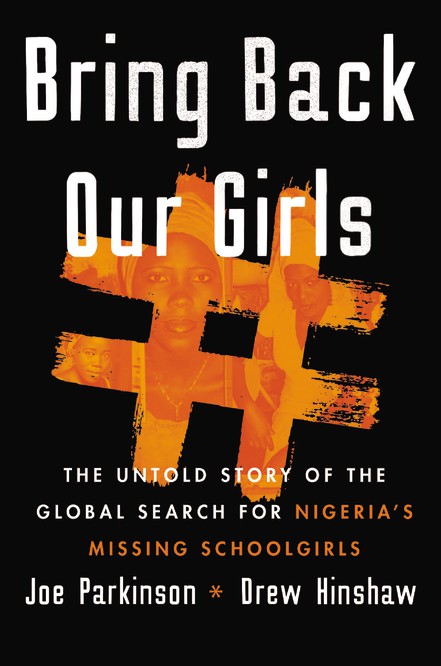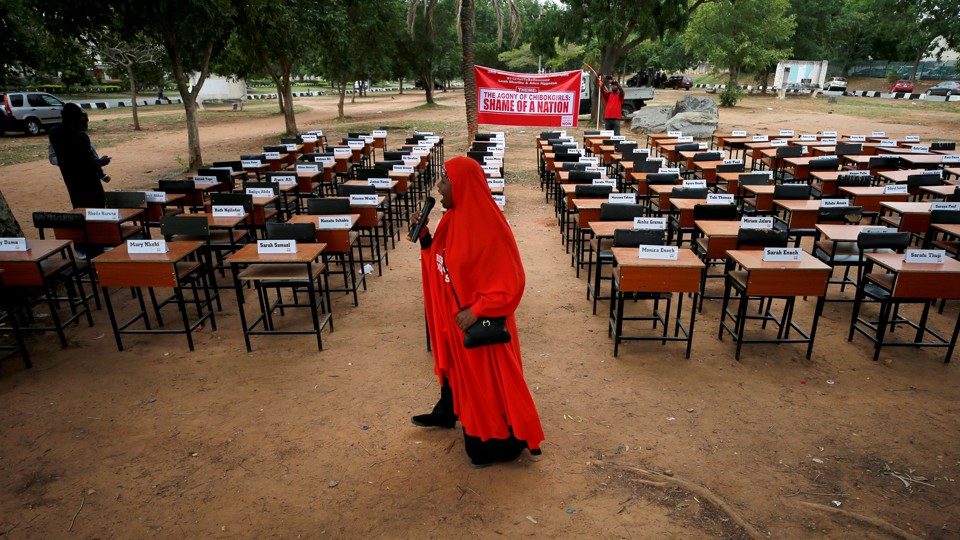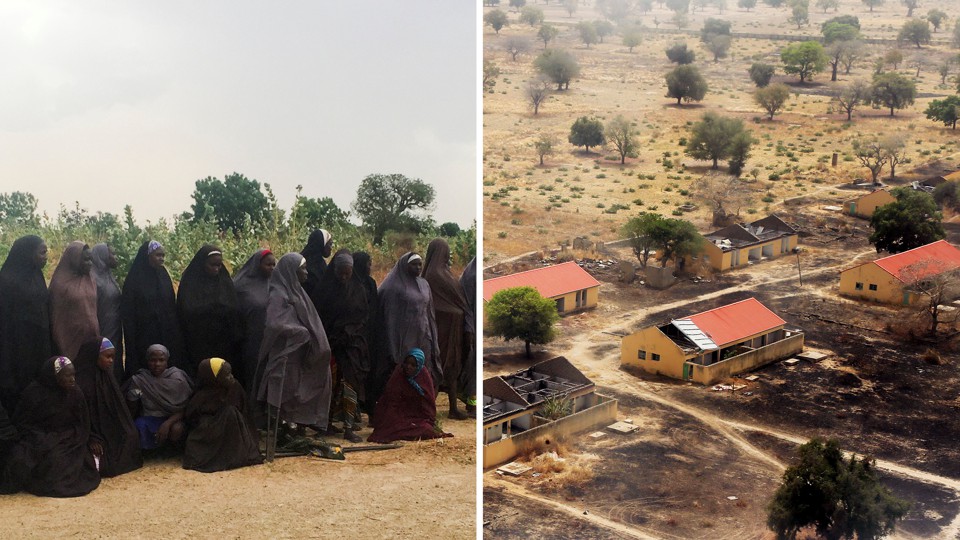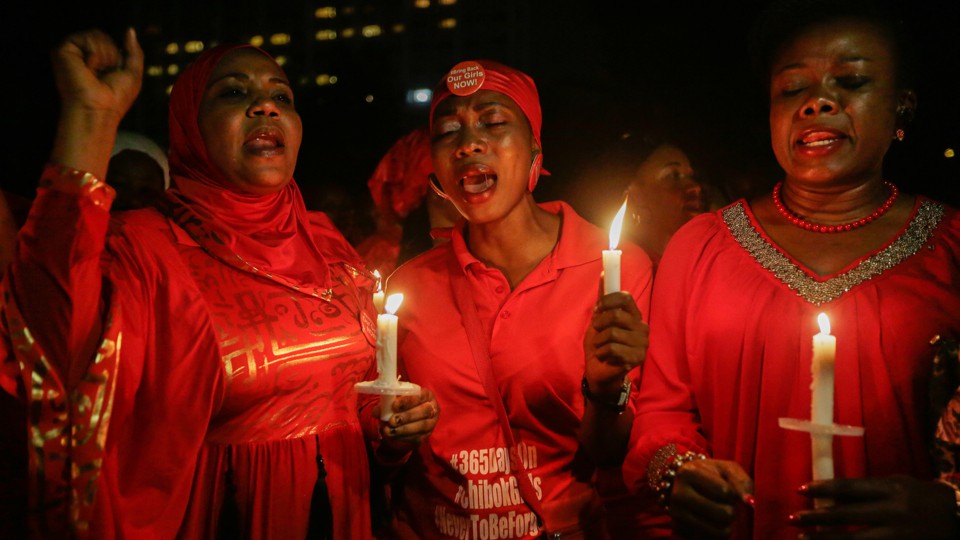In 2014, three months after Boko Haram militants kidnapped 276 girls from a school in the northeastern Nigerian town of Chibok, a photo landed on a bank of monitors in the CIA’s Abuja station, a group of sealed drop-ceiling rooms concealed behind the blast-proof walls of the United States embassy.
The picture was the spy agency’s best clue in months as to the location of the Chibok girls. It had been forwarded over an encrypted channel from an American air base in Ramstein, Germany, where drone and satellite footage had been collected. On the screens glimmered a full-color image, described to us by several current and former American and British defense and intelligence officials and diplomats who, like many of those we interviewed about this episode, declined to be identified in discussing sensitive intelligence and diplomatic details.
In the image were about 80 young women in full-length mayafis standing about in the sun, just far enough beyond the branches of a gigantic, craggy baobab-like tree to be visible to the high-definition cameras peering down at them. They were near a handful of men who appeared to be their guards. Pickup trucks were parked by a small mud-brick structure with a shiny tin roof.

For months, American intelligence officers had been analyzing the rolling landscape of vacant desertlike terrain and ordinary villages, hoping to find some hint of the schoolgirls. The CIA kept two agents on payroll in the region, locals the agency considered reliable but who had proved unable to report back any indications of the students’ whereabouts. The British had trained an informant close to Boko Haram at the elite Royal Military Academy Sandhurst, but Nigeria’s military had arrested him and he’d since vanished.
All told, analysts had received no lead as promising as the photo. It eventually landed in the Pentagon, where officials flagged it up the chain of command. Seeing so many young women in the open was unusual, military analysts agreed. One American defense official who reviewed the photo said the women clearly were hostages. “We’re assuming it’s not a rock band of hippies out there camping,” he told us. The photo quickly worked its way through the U.S. national-security architecture all the way to President Barack Obama’s morning briefing. In time, it would gain a nickname: “the Tree of Life.”
[Read: In the land of Nigeria’s kidnapped girls]
Outside the Abuja CIA station, the American rescue effort in Nigeria had been stuttering in the months since the president had issued the order to “do everything we can” to bring the Chibok girls home. U.S. drones had been flying missions over a huge portion of the Sambisa Forest and beyond to the borders of Cameroon, Chad, and Niger, but on the ground below, Boko Haram was attacking town after town. Every day seemed to bring grisly new headlines of a murderous attack on a military base, the bombing of a church or mosque, or the sacking of a village, followed by the summary execution of fighting-age men and the forced conscription of their sons. More young women had gone missing.
The death toll was breaching new thresholds in the now-five-year-old war. More than 14,000 people were known to be dead, and about half a million were on the move, fleeing for the safety of more heavily defended cities. Army convoys were so routinely ambushed in the countryside that soldiers had begun to retreat, leaving villages and smaller towns to the insurgents.

As the uprising expanded, its fighters swept up hundreds more hostages, sending fresh reports into Abuja of boys who had been forced into combat and of girls forced into slavery. Almost none of these abductions was noticed beyond Nigeria. In May, while some of the most famous people in the world were tweeting about Chibok, militants seized six villages in the nearby mountains and rounded up children from each, with virtually no coverage outside the Nigerian press. In June, the group raided a village only a few hours from the Chibok school and kidnapped another 60 women and girls, along with 31 boys. By the end of the year, after the sect had grabbed 300 more boys from an elementary school in the region, the Chibok abduction was no longer the conflict’s largest kidnapping.
Nevertheless, it would remain Nigeria’s most famous. In early May, the White House deployed a 38-member rescue team, including two FBI hostage specialists, military intelligence analysts, and psychosocial therapists. The crew arrived in Abuja with its own office-support clerk, who set up a front desk in a spare area of the U.S. embassy.
The team stayed in the 667-room Hilton where Nigerian President Goodluck Jonathan had held his ill-fated World Economic Forum in May. By July, it filled up with other guests coming from around the world to help with Chibok. On July 13, Malala Yousafzai celebrated her 17th birthday in the hotel as the guest of honor at a dinner to raise support for the missing girls. Washington lobbyists, hired by Nigeria’s government on a $1.2 million contract to change “the international and local media narrative,” were staying in a 10th-floor executive suite. Around the same time, on the same floor, in rooms booked by the government, four men who claimed to be senior Boko Haram members were holding hostage talks that went nowhere.
On another floor was an Anglican priest who was friends with the archbishop of Canterbury and had flown himself in from Western Australia, bringing screenshots from Google Earth that he believed showed Boko Haram camps where the girls might be. Jonathan had given the priest unlimited funds and the use of a military helicopter, whereupon he vanished into the countryside, returning with sordid-but-inaccurate stories about the girls’ whereabouts and treatment. The government had also given money to his partner, a mysterious Maiduguri woman who called herself Mama Boko Haram and boasted of having once cooked thick, oily egusi, a protein-rich Nigerian stew, for Abubakar Shekau, the leader of Boko Haram. Jonathan’s administration was throwing money at the problem, and the Hilton was filling up with con artists, foreign and local, who wanted to catch it. Meanwhile, on the highway median across the street, Oby Ezekwesili, a former education minister who had helped popularize the hashtag #BringBackOurGirls, gathered with protesters every day at 4 p.m. “What do we want?” her fist-pumping supporters chanted. “Bring back our girls! Now and alive!”
[Read: The ordinary perpetrators and victims in the Boko Haram kidnapping]

The American team left the hotel regularly to meet at the U.S. ambassador’s gated hilltop residence for tea with delegations from the governments of Australia, Britain, Canada, France, and Japan. Diplomats and military personnel shared magnifying glasses to study printouts of American drone footage. Senior Western officials were convinced that they could retrieve the girls, and early on they had assured each other that, at a minimum, they would rescue at least some of them.
And yet the Tree of Life photo was not just a snapshot of the hostages but a window into the mission’s ethical complexities. The ambassador’s table debated whether the Nigerians could be trusted with the photo. The British envoy urged caution, warning that the air force “would simply bomb the baobab tree.” Their host country was fighting a brutal war and considered defeating Shekau a bigger priority than rescuing the schoolgirls that the warlord had turned into human shields. Western allies, on the other hand, were responding to public pressure to rescue one particular group out of the hundreds of children kidnapped by Boko Haram, a victory that might not change the tide but would provide a feel-good moment for a superpower that had little to show for its trillion-dollar counterterrorism adventures.
Western news articles were identifying Boko Haram principally as the group that had kidnapped 276 schoolgirls, not as the killers of thousands of Nigerians. An insurgency that opposed Western education was understood by Americans as opposing girls’ education. The abduction of the Chibok children had originated as an example of the identifiable-victim effect, a phenomenon wherein a single incident allows people to care about a larger tragedy, much as the story of Anne Frank helps young readers connect to the Holocaust. But somewhere in the social-media storm, the dynamic had inverted, and to Western public opinion, the missing schoolgirls had become more important than the war.
All through July, people in cities as big as New York and as small as Bradford, England, held candlelight vigils, while in Washington, D.C., members of Congress dialed the State Department demanding updates. Michelle Obama’s chief of staff continued to ask about the Chibok girls in the president’s morning security briefing. The military was under pressure from the Senate to review its options. Senator John McCain, himself once held hostage in Hanoi, privately lobbied the Pentagon for Special Forces to rescue them. When the U.S. ambassador to Nigeria went home for his son’s graduation, he overheard a distraught young woman in a Chicago sandwich shop complaining to her parents: “These girls are missing and nobody is doing anything, because they’re Africans.”
The Nigerians who sat around the long table at the newly formed Fusion Center, a sealed conference room for sharing information at Abuja’s Office of the National Security Adviser, knew that the U.S. wasn’t trusting them with the full intelligence picture. Americans would arrive with new leads, but they needed clearance from Washington to share any significant piece of intel, a process that took up to 72 hours. The photos the Americans brought in were lo-fi, grainy printouts that the Nigerians knew had been purposely degraded, and they felt condescended to.
The Americans were withholding information because they didn’t entirely trust the Nigerians and because they didn’t want to reveal the extent of the imagery, phone calls, and private messages their drones could capture. The distrust stretched beyond the drone footage. Intelligence officers posted to the CIA station in Abuja were listening to intercepted calls in Nigerian languages they couldn’t translate or in some cases identify, but they didn’t share these with their hosts. The U.S. had hacked into emails, texts, and phone calls from Nigeria’s military that included incriminating details on the number of prisoners who’d died in Maiduguri’s Giwa Barracks. At one point, a U.S. drone took high-resolution photos of a Nigerian military base, and an official bringing the latest stack of photos to the Nigerian government forgot to yank the printouts from the pile until the last minute.
The spying went both ways. American officials would return to the Hilton to find their room “tossed,” their belongings conspicuously rearranged—a warning that they took to mean they were being watched. Eventually, arguments erupted. The Nigerians felt the Americans were too prescriptive, as if Africa’s most populous nation was subservient to the U.S. “Obama is not our president! You’re not in Washington now!” one had shouted across the Fusion Center table. Privately, the Americans griped that the Nigerians didn’t seem interested in resolving the kidnapping.
Other international efforts were also unraveling. The British spy plane sent to scour the search zone broke down and had to return to a base in Senegal. French intelligence struggled to confirm London’s suspicion that the schoolgirls had been trafficked over the border into Cameroon, or possibly Niger. No Nigerian officials ever recalled seeing the satellite images China promised to send.
[Read: The blood-stained hunters of Boko Haram]

After a few weeks in the Hilton, the FBI hostage specialists flew home, and their teammates began to feel unwelcome in the cramped embassy back office where they were working long days writing briefing papers and proposals that the Nigerian government didn’t act upon. The Nigerians were losing territory, soldiers were going AWOL, and many of their helicopters had been destroyed. Some simply hoped the Americans would solve the problem. Eventually, Jonathan himself asked Secretary of State John Kerry to send combat troops.
The American and British discussions about a possible special-forces rescue never gained traction. Deploying helicopters to such a remote area and freeing more than 200 hostages simultaneously was hard enough under the best conditions, but Nigeria also lacked the infrastructure for the mission. The government had spent hundreds of millions of dollars building airports, but in the morass of corruption, key radars barely functioned and runways lacked lights, meaning that any operation would have to take place by day or from another country. Moving enough aircraft or armored cars into the area meant risking notice by an onlooker or someone breaking the news on Twitter. In other words, the intense global focus on whether the girls would be rescued was part of why they couldn’t be.
In August, officers in the CIA’s Abuja station saw that the women in the Tree of Life photo had been moved. Nobody remained under the tree, and the trail had gone cold. All told, U.S. drones spotted clusters of young women in the search zone about five times, but no group as large as that in the Tree of Life photo. No one was ever certain that the individuals in the photos were the Chibok girls, and soon, the drones circling Lake Chad were redeployed over Iraq and Syria, where the Islamic State was holding Americans hostage. By the end of the year, the only members of the American team left were a handful of military intelligence officers, staring into a bank of monitors, studying the occasional picture beamed in from a satellite.
They had ridden into Abuja on a wave of optimism but before long, they were struggling under a cloud of impotence. Nursing sundown drinks at the Hilton, they were philosophical about the limitations of American power. “Everybody thinks, Oh you’re the United States, you can just fly some troopers in there and go in and rescue them,” one said. “It’s not that simple.”
This post was excerpted from Parkinson and Hinshaw’s upcoming book, Bring Back Our Girls.
from The Atlantic https://ift.tt/2OgL2c3
via ATLANTIC

No comments:
Post a Comment